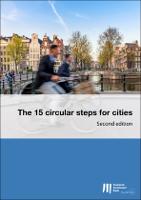The 15 circular steps for cities – Second edition
| dc.contributor.editor | European Investment Bank | |
| dc.date.accessioned | 2021-05-08T03:34:27Z | |
| dc.date.available | 2021-05-08T03:34:27Z | |
| dc.date.issued | 2021 | |
| dc.identifier | OCN: 1256403013 | |
| dc.identifier.uri | https://library.oapen.org/handle/20.500.12657/48529 | |
| dc.description.abstract | The transition to a circular economy not only conserves resources, but also reduces environmental and climate impacts. It fosters innovation and thereby increases competitiveness and creates new jobs. Cities can be cradles and catalysts for a circular transition. This guide provides concrete guidance on how a linear city can start the circular journey. | |
| dc.language | English | |
| dc.rights.uri | Copyright held by content provider | |
| dc.subject.classification | bic Book Industry Communication::K Economics, finance, business & management::KF Finance & accounting::KFF Finance | |
| dc.subject.classification | thema EDItEUR::K Economics, Finance, Business and Management::KF Finance and accounting::KFF Finance and the finance industry | en_US |
| dc.subject.other | Business & Economics | |
| dc.subject.other | Finance | |
| dc.title | The 15 circular steps for cities – Second edition | |
| dc.type | book | |
| oapen.identifier.doi | https://doi.org/10.2867/053396 | |
| oapen.relation.isPublishedBy | 66479d04-7b84-49c0-9a4d-db552a3ecc71 | |
| oapen.relation.isFundedBy | b818ba9d-2dd9-4fd7-a364-7f305aef7ee9 | |
| oapen.relation.isbn | 9789286149658 | |
| oapen.collection | Knowledge Unlatched (KU) | |
| oapen.imprint | European Investment Bank | |
| oapen.identifier | https://openresearchlibrary.org/viewer/41803a41-3ec8-4d39-bd77-d056a770fd07 | |
| oapen.identifier.isbn | 9789286149658 |

